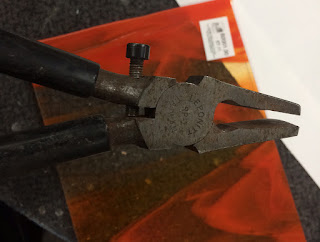There are a wide variety of cut running pliers for different
purposes. A description of some of them
is here.
The plastic covers that come with these cut runners eventually wear
out. The replacements are hard to find.
There are things you can do other than buying a new pair just for the shields.
You can dip the jaws in tool coating compounds such as Plastidip. This does not last as long as the plastic,
but is easy to re-do.
You can wrap the jaws in tape.
Electrical tape, duct tape or even self-adhesive elastic bandage will do
the job. Again, not long lasting, but easy to replace.
Or
You can use the cut running pliers without any covering on the
jaws. “You can’t do that. You will crush
the glass!” is the response I hear. You
can use them bare. I do, and so can you.
The key is in the adjusting screw.
It is there not just to tell you which is the top of the pliers; it has
a function too. That screw adjusts the
opening of the jaws to the thickness of the glass.
A simple way to ensure you have the correct opening is to put one corner
of the jaw on the edge of the glass with the jaw opening less than the glass is
thick. Then tighten the screw until you feel the handles of the pliers begin to
open. Then you have the right opening for
the thickness of the glass.
It ensures you cannot crush the glass, as the jaws will not close at the
centre to be less than the glass thickness.
You also have a more direct feel of the glass without the spongy
connection of the plastic. You can sense the glass beginning to bend just
before the score runs due to the gentle pressure of the jaws of the cut runners
on either side of the score.
Whether you use the cut runners with or without cushions on the jaws, it is important to keep the adjustment screw lubricated so you can adjust the width of the jaw opening for different thicknesses of glass.
Whether you use the cut runners with or without cushions on the jaws, it is important to keep the adjustment screw lubricated so you can adjust the width of the jaw opening for different thicknesses of glass.



























